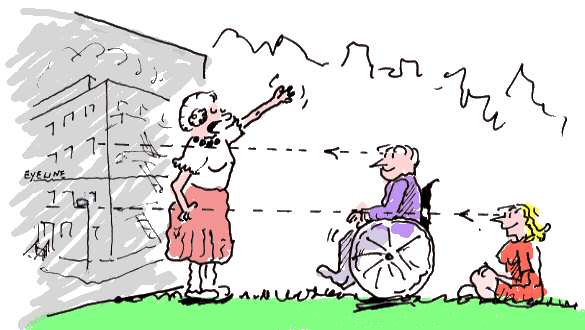SCENERY PAINTING
FOR THE AMATEUR MUSICAL THEATRE and PANTOMIME |
My name is Denise and for 1 week a year for the past 25 years I have worked with a theater group within a camp for folks with special needs.
My various duties have included, acting, singing, sewing costumes, and always painting the scenery. 23 years ago a wonderful theater arts teacher taught our amateur crew to make stage flats. There are 16 - 4ft x 8ft flats which have served as the backdrop to all of our productions since that day.
Each year we simply paint over the scenery from the previous year and create anew. Some years we have tried to create actual interior scenes or exterior scenes. Some years the flats serve as abstract murals depicting the sense of the show. The shows are performed outside and the flats are freestanding, with the audience sitting on the ground or in wheelchairs in front of the actors. We perform for 5 nights, each night begins a new scene ,we pick up in the story line where we ended the night before, very much like a soap opera.
This year we are performing Annie. This was actually the first scenery painted 23 years ago. I suggested peeling off the layers, I'm getting up there in age and am recovering from a broken ankle, so moving around isn't as easy as it was long ago.
Well we're going to go for a new look, so I started my search at google images. I thought perhaps dividing the flats into three sections. NYC, the Orphanage, and Warbucks House. So I clicked New York City Skylines. The search led me to your page. What an inspiration you are. I so appreciated all of your suggestions. I received a degree in Art 24 years ago and have tried to remember all of the techniques for perspective and shading, but unfortunately I have only been able to use my painting skills each year at this time.
One question, where would you place the "eyeline" for an audience that is seated at the feet of the actors? This has proven to be a challenge everytime I try to make a scene using perspective. Any more words of wisdom would be greatly appreciated.
Thank you,
Denise
Hi Denise,
First of all do you really need to slavishly stick to an eyeline? Many set designers think this restricts their freedom to paint a scene. However, if the answer is "yes" then here are my thoughts.
People sitting on the ground and others in wheelchairs inevitably mean a compromise. You can't accurately pander to both "customers" so my advice is to split the difference.

Measure how high off the ground the eyes of the average wheelchair user are... probably be about 1.22m (four feet) and also the height off the ground the sitting person's eye ... probably about 0.7m (2'3") . Split the difference and you end up with an eyeline to be drawn on your flats at about 0.95m (3'1") from the bottom
Or alternatively, who will form the bulk of your audience- wheelchairs or sitting-on-the-grounders? Then draw the eyeline for the largest number of customers. Your audience will not be aware of the descrimination I can assure you.
Hope this helps.
23 years of painting over the same flats. I bet they are quite heavy by now. I love the idea of presenting a show over five days, and in the open air too. Best of luck with the production.
Regards, Brian